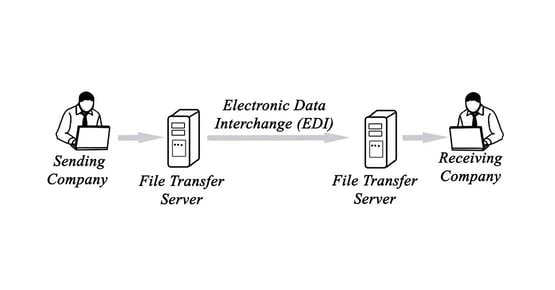On this page
Subscribe for updates
Keep up with OrderEase and access industry-leading order operation insights.
Manual order processing is costly, slow, and error-prone. Every time a purchase order is re-keyed from an email or PDF, the risk of mistakes rises. Those errors don’t just waste time; they create chargebacks, shipping delays, and strained customer relationships.
EDI substitutes these manual transactions with purposeful and computerized transmissions that transfer documentation, e.g., purchase orders, invoices, and shipping instructions, directly through a computerized exchange between the two systems.
Using EDI, orders are cleanly transferred into your ERP, acknowledgments are received immediately, and shipments can be traced through delivery.
Modern solutions such as OrderEase make these benefits go further. Instead of handling just traditional EDI flows, OrderEase unifies all orders, EDI, emailed POs, sales rep entries, buyer portals, and even eCommerce Marketplaces into a single streamlined flow.
The result? Faster cycle for ordering, reduced errors, and a scalable system that will grow without headcount.
EDI – The Foundation of Modern B2B Trade

Electronic Data Interchange (EDI) refers to a standardized method of exchanging documents, including purchase orders, invoices, and shipping notices, between trading partners. EDI operates not based on emails, PDFs, or faxes, but on a direct system transfer between systems in a structured digital format.
ANSI X12 in the United States of America and EDIFACT in global nations will be the two primary standards. They also make sure that all systems are compatible and that orders, invoices, and shipping updates can be effortlessly transferred between businesses.
It generates an order-to-cash cycle that is touchless: purchase orders are processed automatically, acknowledgments can be made immediately, purchase orders are matched on the following invoice, and rececharacteristics, shipments can be tracked all the way through.
The use of APIs and portals is applicable in certain operations, but in the large-scale and repetitive utility of B2B transactions, EDI continues to be the backbone of the modern-day supply chain.
The Core Benefits of EDI for Modern Businesses
When businesses replace manual processes with electronic data interchange, the gains are immediate and measurable, ranging from lower costs to faster, more accurate order cycles. Let’s take a look:
- Cost Savings and Efficiency
Cost savings are one of the most recognized benefits of EDI. Manual data entry has an error rate of up to 4%, or 40 errors per 1,000 entries. Each mistake consumes staff time, raises labor costs, and can even trigger chargebacks.
By automating these exchanges, EDI reduces transaction costs by as much as 90%. OrderEase goes a step further and digitizes emailed POs, PDF files, spreadsheets, and CSV files into clean digital orders. This removes re-keying, saves posting to ERP or accounting, thus allowing staff to concentrate on high-value work rather than tedious inputs.
- Faster Business Cycles
EDI documents move in minutes, not hours or days, which means near real-time order capture and fulfillment.
OrderEase accelerates this by unifying all orders, EDI, sales reps, portals, and email into a single queue. The platform automatically confirms and recognizes orders by condensing orders into 855 confirmations individually and provides immediate notification if an exception occurs. Teams can respond to customer delays before the actual availability, leading to improvements in order-to-cash cycle times, as well as replenishment time and more reliable service.
- Improved Accuracy and Error Reduction
One of the most obvious advantages of EDI is the elimination of human error. Manual re-entry tends to result in mismatches of SKU, incorrect pricing, or incorrect unit of measure. EDI completes and verifies documents, prompting the delivery of complete and correct documents.
OrderEase improves on this by making sure that invoices (810s) and purchase orders (850s) Silas checked against the requirements of the partner before they enter your ERP. Quantity or pricing mismatches are detected at the initial stage, and exceptions with full audit trails are sent back.
The result is near-perfect accuracy, fewer disputes, and less wasted time on reconciliation.
- Real-Time Visibility Across the Supply Chain
Visibility is another core benefit of electronic data interchange. While EDI fulfills its purpose by providing a traceable route through documents such as the 855 (acknowledgment), 856 (advance ship notice), and 810 (invoice), traditional processes bury order status in email, spreadsheets, or other documents that simply aren't dynamic.
OrderEase consolidates this visibility by bringing all orders, EDI & non-EDI into one dashboard. Teams see all orders in real time, advanced shipping notices are automatically passed into receiving workflows, and finance has full audit trails of invoices and acknowledgments. This transparency renders the internal coordination strong and the trading partners aligned.
- Stronger Partner Relationships and Compliance
For many retailers and distributors, EDI compliance isn’t optional. Partners such as Walmart, Target, and Macy’s require it, and failure often leads to fines, chargebacks, or even lost contracts.
EDI provides partners with the necessary standardized and validated data interchange. OrderEase streamlines compliance with automated enforcement of each partner's rules, providing and timely acknowledgment of orders, SLA metering clock, and exception reporting, and flagging exceptions before they become an expensive problem. The result is greater reductive chargebacks, stronger scorecards, and healthier partnerships.
The Specific Advantages of OrderEase EDI
1. Beyond Traditional EDI
Traditional EDI systems only manage structured partner exchanges, leaving other order channels outside the workflow. OrderEase closes that gap by unifying multi-channel order management:
- Email-to-EDI – Converts emailed purchase orders, PDFs, spreadsheets, and CSVs into digital EDI orders.
- Rep App & Buyer Portals – Captures sales rep and portal entries and feeds them into the same workflow as EDI transactions.
- ERP & eCommerce Integration – Works smoothly with the help of QuickBooks, NetSuite, Shopify, Amazon, and multiple others to ensure data flow in real-time.
2. End-to-End Invoice Automation (810s)
Invoice automation is one of the most important roles EDI plays in eCommerce and retail supply chains. OrderEase manages the full 810 lifecycle:
- Ingest – Receives 810s from partners via AS2, SFTP, VAN, or API.
- Validate – Confirms invoice numbers, terms, taxes, and totals.
- Acknowledge – Sends timely 997 receipts to confirm structure.
- Match – Links invoices to purchase orders and receipts.
- Post – Creates payables in ERP systems with full audit trails.
- Triage – Routes mismatches to owners with severity levels and due dates.
This reduces errors, speeds up payment, and ensures financial accuracy on scale.
3. Scalability Without IT Overhead
Scaling traditional EDI can be costly, requiring specialized staff and middleware. OrderEase changes this equation by offering:
- Cloud-based scalability that grows with transaction volumes.
- Automated compliance updates reduce IT maintenance.
- A user-friendly interface that doesn’t require a dedicated EDI team.
This is a critical advantage of EDI in business. OrderEase makes enterprise-grade automation accessible even to SMBs without internal IT depth.
Best Practices for Maximizing EDI Benefits with OrderEase
To capture the full advantages of electronic data interchange, businesses should follow these best practices:
Focus on High-Impact Transactions First
OrderEase makes it easy to get started at the source of the biggest payoff: High volume transactions such as purchase orders (850s) and invoices (810s). By targeting these documents initially, companies will have the ability to attract quick wins and gain confidence with their trading partners, as well as create momentum for broader adoption.
Build Seamless Connections to Core Systems
True efficiency only comes when EDI goes directly into your ERP, warehouse management, or accounting platforms. OrderEase integrates natively to systems such as QuickBooks, NetSuite and Shopify and ensures that sales, finance, and operations are all working from the same real-time data set. This integration removes silos and keeps every department in line.
Stay Ahead of Exceptions
No EDI system is perfect, with the exceptions are managed well. With OrderEase, alerts, dashboards, and automated routing ensure late acknowledgments, mismatches, and partner-specific issues are sorted out before they create delays or chargebacks. Exception management is using what might be a disruption to the business as a means for proactive customer service.
Expand Adoption at a Manageable Pace
Successful EDI programs develop one step at a time. OrderEase offers a centralized hub to reliably onboard new partners in no time without flooding IT. By rolling out to a couple of partners first, then growing quarterly, businesses can grow their digital footprint without losing stability of operations.
Conclusion
EDI has evolved from a back-office efficiency tool to the basic driver of competitiveness. For businesses in the distribution, manufacturing, and retail sectors, it delivers what today's market demands: lower costs, faster order cycles, cleaner data, and firewalls compliant.
OrderEase EDI goes one step further by unifying all order streams, EDI, email, sales reps, portals, and marketplaces into one unified system. Automating the invoice validation process, simplifying purchase order management tasks, and making partner compliance a breeze ensures businesses can grow without accumulating administrative overhead.
In this day and age, where manual processes are holding companies back, OrderEase provides the clarity and control to scale with confidence. The future is of businesses that embrace automation, and with OrderEase, the future is here right now.
FAQs
How much can EDI reduce my operational costs?
EDI can be used to cut operational costs by up to 90%. The automation of document exchanges frees employees from having to enter data into something manually, which not only saves time and manpower but also avoids errors and the time spent correcting them. By accelerating their order-to-cash process and eliminating paper-based processes, businesses can also save on other materials such as paper, ink, and postag,e as well as save on administrative overhead.
How can EDI streamline my supply chain operations?
EDI clarifies supply chain movements by automating the exchange of data file between trading partners. With EDI, purchase orders, invoices, and notification of shipment are sent directly from one system to another without the manual handling and delays associated with the traditional methods of communication. This centralized process results in better visibility, faster order fulfillment, and shorter cycle times, which in turn results in a more efficient and responsive supply chain.
How does EDI enhance data accuracy and security?
EDI improves the accuracy of the data since it reduces the occurrence of human error that is common during manual data entry. The standardised nature of EDI documents helps guarantee that orders, invoices, and shipping notices are correctly formatted, plus include all the relevant information needed (which goes some way towards cutting mistake-making, such as incorrect SKUs or incorrect pricing). In terms of security, EDI transactions are usually exchanged with the help of secure protocols such as AS2 or SFTP, which means sensitive information of the business will be encrypted and protected from unauthorized access.
How does EDI improve collaboration with trading partners?
EDI enhances business collaboration and slavery by facilitating real-time standardized communication between various businesses and their trading partners. Rather than using emails or faxes, which can cause delays and communication errors, EDI enables immediate communication between a firm and its client, with important documents like purchase orders and invoices.
What challenges does EDI help businesses overcome?
EDI helps to overcome a number of difficulties facing businesses. First, it removes the need for manual data input, which can be a time-consuming and error-prone task. EDI ensures that orders and invoices are validated and aligned, which reduces any discrepancies and avoids any costly disputes. By automating processes such as order processing and invoicing, EDI helps to make the supply chain much more efficient, reducing cycle times and improving productivity. EDI is also critical to enabling businesses to comply with any regulations set by them by automating the process of following our partner-specific requirements, which will cut down the chances of penalties or penalties (chargebacks).
Integrate Your ERP
Ready to automate order data directly into your ERP? Discover integrations offered by OrderEase.
-4.png?width=1600&height=800&name=Blog%20Imagery%20(3)-4.png)

